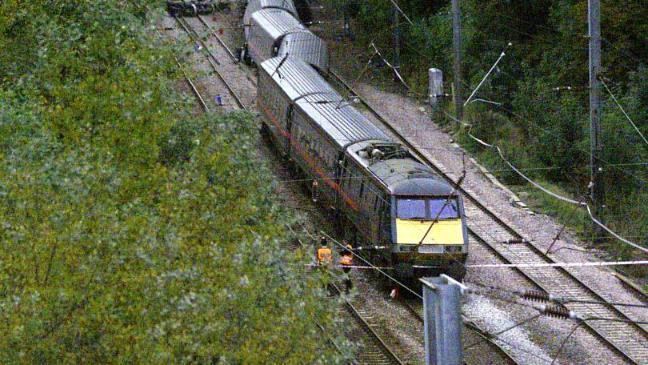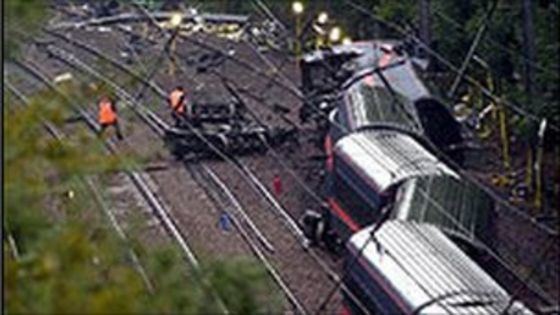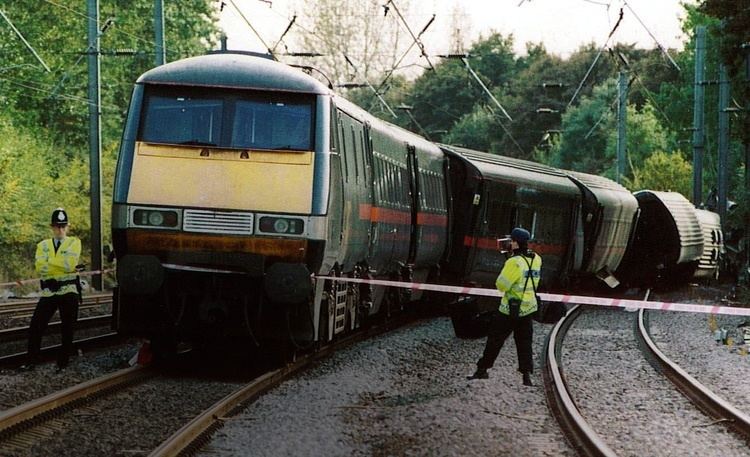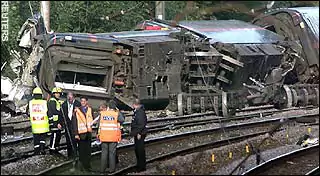Time 12:23, (UTC) (Z) Passengers 170 Date 17 October 2000 Passenger count 170 Location Hatfield | Country England Cause Broken rail Injuries Over 70 Total number of deaths 4 Trains 1 | |
 | ||
Similar Ladbroke Grove rail crash, Great Heck rail crash, Southall rail crash, Potters Bar rail accidents, Grayrigg derailment | ||
Bbc 6 o clock news titles hatfield rail crash october 17 2000
The Hatfield rail crash was a railway accident on 17 October 2000, at Hatfield, Hertfordshire, UK. It was caused by a metal fatigue induced derailment, killing four people and injuring more than 70.
Contents
- Bbc 6 o clock news titles hatfield rail crash october 17 2000
- Hatfield rail crash
- Accident
- Cause
- Aftermath
- Court case
- References

Though the accident did not result in a large number of deaths, it exposed major stewardship shortcomings of the privatised national railway infrastructure company Railtrack. Reports found there was a lack of communication and some staff were not aware of maintenance procedures. Railtrack subsequently went into administration and was replaced by Network Rail. The aftermath of the accident saw widespread speed limit reductions throughout the rail network and a tightening of health and safety procedures, the repercussions of which were still felt up to 15 years later. In 2005, both Network Rail and the contractor Balfour Beatty were found guilty of breaching health and safety laws.

Hatfield rail crash
Accident

A Great North Eastern Railway (GNER) InterCity 225 train bound for Leeds had left London King's Cross at 12:10, and was travelling along the East Coast Main Line at approximately 115 miles per hour (185 km/h) when it derailed south of Hatfield station at 12:23. The train was being driven by an experienced driver, accompanied by a trainee who was expected to take over at Leeds. The primary cause of the accident was later determined to be the left-hand rail fracturing as the train passed over it.

The train travelled a further 1,000 yards (910 m) after derailment. The leading locomotive and the first two coaches remained upright and on the rails. All of the following coaches, and the trailing Driving Van Trailer were derailed, and the train set separated into three sections. The restaurant coach, the eighth vehicle in the set, overturned onto its side and struck an overhead line gantry after derailing, resulting in severe damage to the vehicle. The whole incident occurred in 17 seconds.
Four passengers died in the accident and a further 33 were initially reported as injured, three seriously. The number of injured was later revised to over 70. Those who died were all in the restaurant coach:
Two of those seriously injured were GNER staff working in the restaurant coach at the time of the accident. Emmerdale actress Anna Brecon was travelling on the train, and suffered minor cuts and bruises.
Crash investigators found the British Rail-designed Mark 4 coaches, aside from the restaurant coach, had good structural integrity and remained intact after the accident. Coincidentally, the locomotive in the crash was also involved in the Great Heck rail crash (where the leading Driving Van Trailer hit a road vehicle on the track) a few months later.
Cause
A preliminary investigation found a rail had fragmented as trains passed and that the likely cause was "rolling contact fatigue" (defined as multiple surface-breaking cracks). Such cracks are caused by high loads where the wheels contact the rail. Repeated loading causes fatigue cracks to grow. When they reach a critical size, the rail fails. Portions of the failed track at Hatfield were reassembled and numerous fatigue cracks were identified; these contributed to spalling of the running surface to around five millimetres (0.20 in) deep and 100 millimetres (3.9 in) long.
The problem was known about before the accident; a letter from the infrastructure company Railtrack in December 1999 warned that the existing Railtrack Line Specification was insufficient to guard against this type of fatigue. Replacement rails were made available but never delivered to the correct location for installation.
Since privatisation, Railtrack had divested the engineering knowledge of British Rail into contractors. While it had comprehensive maintenance procedures that might have prevented the accident if followed appropriately, later investigation showed there was a serious problem with the experience and working knowledge of staff. In a subsequent interview, the Zone Quality Standards Manager said, "I do not have knowledge of railway engineering nor railway safety," which was completely contrary to the written requirements for the role. In May 1999, the Head of Track had said that insufficiently skilled work was causing more rails to break. Railtrack did not know how many other cases of rail fatigue around the network could lead to a Hatfield-like accident and consequently imposed over 1,800 emergency speed restrictions and instigated a nationwide (and costly) track replacement programme. The company was subject to "enforcement" by the Rail Regulator, Tom Winsor.
Aftermath
In 2004, Arthur's widow was awarded £1m damages in the High Court. The families of the other three fatal casualties received damages out of court. A memorial service was held for the victims on the 10th anniversary of the crash in 2010 at St Etheldreda's Church, Hatfield. A second service was held near the crash site afterwards. Both were conducted by the Rector of Hatfield, who had attended to casualties and the bereaved in the immediate aftermath of the accident in 2000.
The speed restrictions and track replacement works caused significant disruption on a majority of the national network for more than a year. The disruption and Railtrack's spiralling costs eventually caused the company to enter administration at the insistence of Transport Secretary Stephen Byers, and its replacement by the not-for-dividend company Network Rail under Byers's successor Alistair Darling.
Train operating companies were adversely affected by the disruption, losing an estimated 19% of revenue in the year following the crash. Freight operator EWS was cancelling up to 400 trains per week as a result, whilst estimates put Freightliner's resultant losses at £1 million per month. The cost to the entire UK economy of the disruption was estimated at £6 million per day.
The Institute of Rail Welding (IoRW) was set up in 2002 by The Welding Institute (TWI) and Network Rail as a consequence of the recommendations in the investigation report. It provides a focus for individuals and organisations involved in rail welding and facilitates the adoption of best practice.
The aftermath of the crash had long-reaching repercussions in the rail industry. In 2015, at the 15th anniversary of the accident, the Rail, Maritime and Transport union (RMT) said a new system for handling maintenance introduced by Network Rail was confusing, and there was the potential for a similar accident to re-occur. The union's general secretary said that Network Rail needed to act on their concerns, otherwise there would be industrial action.
Court case
In 2003, five managers and two companies – Network Rail (as successors of Railtrack) and the division of Balfour Beatty that maintained the track – were charged with manslaughter and breach of health and safety charges in connection with the accident. The managers, Anthony Walker (Balfour Beatty's rail maintenance director), Nicholas Jeffries (its civil engineer), Railtrack's Alistair Cook and Sean Fugill (asset managers for the London North-East zone), and track engineer Keith Lee, all denied the charges. The corporate manslaughter charges against Network Rail/Railtrack and some of its executives were dropped in September 2004, but the other charges stood.
The trial began in January 2005; the judge, Mr Justice Mackay, warned that it could go on for a year. On 14 July, the judge instructed the jury to acquit all defendants on charges of manslaughter. A few days later, Balfour Beatty changed its plea to guilty on the health and safety charges and, on 6 September, Network Rail was found guilty of breaching health and safety law. Network Rail were fined £3.5 million while Balfour Beatty were fined £10 million. All of the manslaughter charges against the executives were dismissed by the judge.
